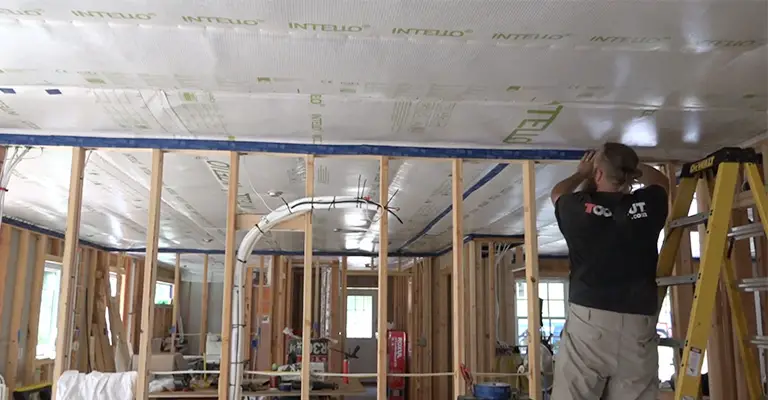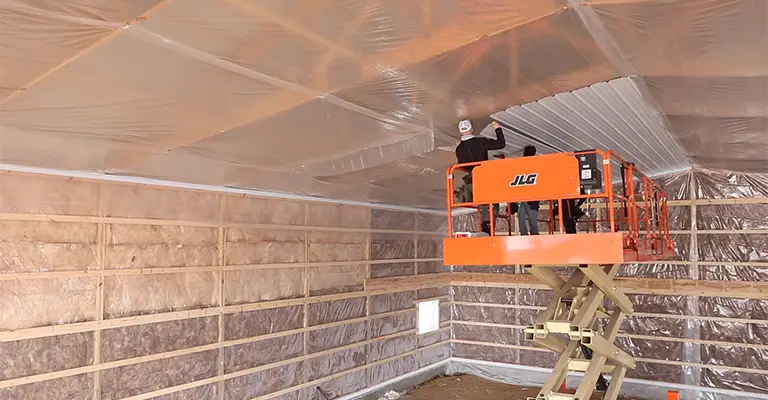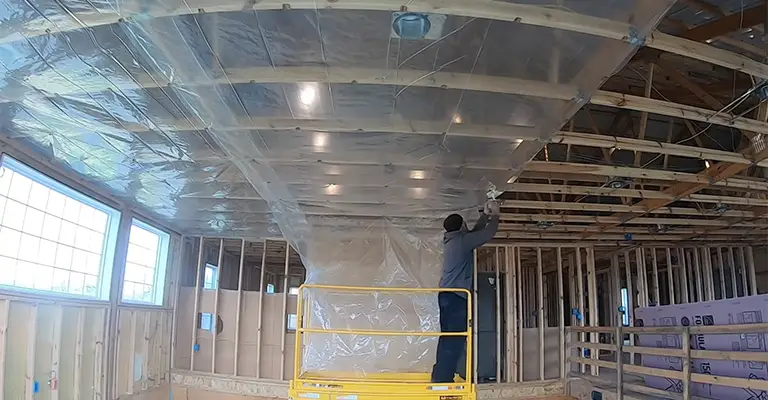Whether to put a vapor barrier on your ceiling depends on the climate and specific conditions. In climates with more than 8,000 heating degree days and vented attics, plastic vapor barriers are recommended.
However, in other climates, excluding hot-humid or hot-dry areas, you can opt for alternatives such as vapor retarders like kraft-faced insulation or latex ceiling paint.
Moisture infiltration can lead to a myriad of problems, from pesky mold growth to structural damage, making it essential to take proactive measures.
One question that frequently arises in this quest for moisture management is whether to install a vapor barrier on the ceiling.
In most states, covering ceiling insulation is a requirement. A radiant barrier and vapor barrier can be used for this purpose.
If you find yourself pondering over this dilemma, you’re not alone. The debate surrounding the effectiveness and necessity of vapor barriers has left many homeowners uncertain about the best course of action.
It’s crucial to avoid putting a vapor barrier directly on the ceiling in any circumstance.
Doing so can trap water vapor on the underside of the barrier, potentially causing damage to the drywall. This is particularly problematic in houses that are overly airtight, hindering moisture escape.
Ceiling Vapor Barrier Debate: What Do The Experts Say?
Ignore the experts, this is what I think.
It is only recommended to install plastic vapor barriers in vented attics in climates with more than 8,000 heating degree days per year.
All other climates, except hot humid or hot dry ones, should use vapor retarders (kraft faced insulation or latex ceiling paint).
A hot humid climate requires no ventilation of attics or the installation of vapor retarders inside assemblies. Attics can be ventilated in hot, dry climates without the use of a vapor retarder.
An air barrier should be installed in all attics, whether they are vented or not. It is actually, sorta, kinda, true that you must let the moisture escape through your ceiling vapor barrier or that the house must breathe out the top.
Also, it’s kinda, sorta wrong. I don’t know what to say about that answer.
For severe cold, cold and mixed climates, as well as for limiting other interior contaminants in all climates, I am a real fan (ha, ha) of controlled mechanical ventilation.
To put it another way, all houses require controlled mechanical ventilation to function properly.
Also, I believe the installation of attic vents and the construction of leaky attic ceilings (or walls) should not be used to achieve this necessary air change.
Due to this, all houses, regardless of their climate, must be equipped with an air barrier and mechanical ventilation that is controlled.
Nevertheless, I am comfortable with relieving some of the moisture load in the house via diffusion (hence the use of vapor retarders rather than vapor barriers) through a roof assembly that can handle it (e.g. a vented attic in a moderately cold climate).
This recommendation is specific to a particular climate. It is impossible for attic ventilation to remove much moisture from a well-insulated attic in a cold climate (more than 8,000 heating degree days).
To remove moisture from attics, attic ventilation requires heat loss. There isn’t much moisture in cold air.
It is not possible to remove moisture from a heavily insulated attic by venting it with the outside air when it is extremely cold outside. For this reason, we don’t want moisture in an attic in a severe cold climate.
In locations with less miserably cold temperatures, this changes. Therefore, vapor barriers are recommended in severe cold climates and vapor retarders in most other locations.
There was a time when, when attics were poorly insulated in severe cold climates, plastic vapor barriers were not needed. Attic ventilation was able to remove moisture from the attic due to the heat loss from the house.
Attic temperature was warmed by escaping heat loss, allowing cold outside air to pick up moisture. The attic was then ventilated to remove moisture.
As long as we added a large amount of attic insulation, the approach worked great. As a result of the added insulation, the attic remained cold, and the outside air was unable to effectively remove the moisture in the attic.
A vapor barrier is therefore needed to reduce moisture flow into the attic. There is one more complication to mention.
In building assemblies, vapor moves in two ways: by diffusion through materials, and by air leakage through gaps and holes.
Moisture is moved more by air leakage than by vapor diffusion. In the absence of an air barrier, a vapor barrier in an attic assembly in a severe cold climate will not work.
A vapor barrier is not necessary, but an air barrier can act as a vapor barrier in the absence of one.
By installing plastic in ceilings and assuming it is also an air barrier, we complicate things. Plastic needs to be continuous in order to serve as an air barrier.
What Type Of Plastic Sheeting Can Be Used To Cover Ceiling Insulation?

In these applications, vapor barriers or radiant barriers are the best solutions.
A vapor barrier is required to cover ceiling insulation in most climates, but not all insulation requires one. Refer to your state’s building codes whenever possible.
Water condenses inside the walls and building envelope when you install a vapor barrier, which can cause deterioration and mold growth.
In northern hot climates, the barrier should face inside, while in southern humid climates, it should face outside.
Vapor Barrier
Insulation around the ceiling can be protected with vapor barriers that are fire retardant.
Radiant Barrier
It is also common to cover ceiling insulation with radiant barrier plastic sheeting. Radiant barriers are inherently insulating, and when they face an air space, their R values increase.
As long as the radiant barrier is properly installed, the summer heat will be kept out and the winter heat will be retained.
Why is it Mandatory to Cover Exposed Ceiling Insulation?

Many safety and health reasons justify the use of radiant barriers or vapor barriers for ceiling insulation. There are different insulation regulations in each state, which can usually be found in the state’s building code.
It is crucial for many states to cover exposed ceiling insulation. Find out why you should cover your ceiling insulation and which material is best.
Increased Fire Risk
Due to its high flammability, exposed insulation is at risk of catching fire if not covered properly. An adverse event that causes a fire will be slowed down if a fire-retardant plastic sheeting is installed over insulation.
Poor Air Quality
It can cause a slew of health problems if insulation is disturbed, especially fiberglass insulation. Builders and residents are protected against toxins, fumes, and air particles in dust that could irritate their eyes, ears, and lungs with plastic sheeting.
Final Words
Depending on the climate, vapor retarders can be an essential part of the wall construction. Incorrect use, however, can cause additional moisture problems.
For more information on where to install a vapor retarder or if you would like to consider a vapor retarder that provides additional flexibility, such as a smart vapor retarder, contact an insulation professional in your area.
If moisture is trapped in the wall cavity, a smart vapor retarder can adapt its permeability to allow the wall to dry.
By altering its physical structure in response to changes in relative humidity, a smart vapor retarder reacts to changes in relative humidity.
When the humidity level is higher on the outside of the wall (winter) or on the inside (summer), this material adapts to let moisture out of the wall. In areas with mixed climates, smart vapor retarders are a good solution.








